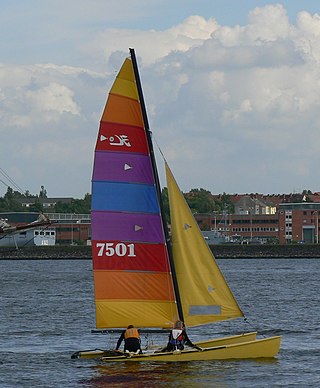
A catamaran is a watercraft with two parallel hulls of equal size. The wide distance between a catamaran's hulls imparts stability through resistance to rolling and overturning; no ballast is required. Catamarans typically have less hull volume, smaller displacement, and shallower draft (draught) than monohulls of comparable length. The two hulls combined also often have a smaller hydrodynamic resistance than comparable monohulls, requiring less propulsive power from either sails or motors. The catamaran's wider stance on the water can reduce both heeling and wave-induced motion, as compared with a monohull, and can give reduced wakes.

The ISAF International Class Hobie 16 (H16) is a popular catamaran manufactured by the Hobie Cat Company for racing and day sailing. The craft was the driving force behind the popularization of beachcats and was recently inducted into the Sailing Hall of Fame.

Hobie Cat is a company that manufactures watercraft and other products as the Hobie Cat Company. "Hobie Cat" can also refer to specific products of the company, notably its sailing catamarans. Its fiberglass catamaran models range in nominal length between 14 feet (4.3 m) and 18 feet (5.5 m). Rotomolded catamaran models range in length between 12 feet (3.7 m) and 17 feet (5.2 m). Other sailing vessels in the Hobie Cat lineup include, monocats, dinghies, and trimarans, ranging in length between 9 feet (2.7 m) and 20 feet (6.1 m). Its largest product was the Hobie 33, 33 feet (10 m) in length. The company's non-sailing product line includes surfboards, kayaks, stand-up paddle boards, pedalboards, eyeware, and e-bikes. It was founded in 1961 by Hobart (Hobie) Alter, who originally manufactured surfboards.

A sailing hydrofoil, hydrofoil sailboat, or hydrosail is a sailboat with wing-like foils mounted under the hull. As the craft increases its speed the hydrofoils lift the hull up and out of the water, greatly reducing wetted area, resulting in decreased drag and increased speed. A sailing hydrofoil can achieve speeds exceeding double and in some cases triple the wind speed.

Hobart "Hobie" Laidlaw Alter was an American surf and sailing entrepreneur and pioneer, creator of the Hobie Cat catamarans, and founder of the Hobie company. He created the Hobie 33 ultralight-displacement sailboat and a mass-produced radio-controlled glider, the Hobie Hawk.
Randolph L. Smyth is an American competitive sailor and two-time Olympic silver medalist. He is a multihull specialist, who won two Olympic silver medals racing catamarans, and has won innumerable national and world titles skippering multihulls. In a 2003 profile on him in Sailing World magazine he was described as America's greatest multihull sailor. He was born in Pasadena, California.

The Hobie Tiger or Hobie Tiger 18, is a French catamaran sailboat that was designed by Hobie Cat Europe as a Formula 18 racer and first built in 1995.
Nacra Sailing is a Dutch company that manufactures a line of small catamaran sailboats, or beachcats. NACRA was founded in 1975 to tap into the market created by Hobie Alter the founder of Hobie Cat, and several other companies offering small fiberglass catamarans designed to be sailed off the beach by a crew of one or two.
James Wharram was a British multihull pioneer and designer of catamarans.

The M32 is a class of sailing catamaran designed by Göran Marström and Kåre Ljung and first built in 2010 by Marstrom Composite AB. The design and production rights were sold in 2013 to Aston Harald Composite AB led by Håkan Svensson and run by Killian Bushe.

The Hobie Wave is an American catamaran that was designed by Morrelli & Melvin and first built in 1994.

The Hobie Bravo is an American catamaran sailing dinghy that was designed by Hobie Cat in 2000 and first built in 2001. The design is intended for sailing from beaches by one or two people.

The Hobie 17 is an American catamaran that was designed by John Wake as a single-handed racer and first built in 1985.
The Cheshire 14 is an American catamaran sailing dinghy that was designed by Frank Meldau as a racer and first built in 1962.

The Hobie 14 is an American catamaran sailing dinghy that was designed by Hobie Alter and first built in 1967.
The Nacra 5.2 is an American catamaran sailing dinghy that was designed by Tom Roland as a one-design racer and first built in 1975. Other than the small production run Nacra 36, the Nacra 5.2 was the first Nacra brand boat and established its reputation.
The Prindle 18 is an American catamaran sailing dinghy that was designed by Geoffrey Prindle as a racer and first built in 1977.

The Prindle 18-2, or Prindle 18.2, is an American catamaran sailing dinghy that was designed as a racer and first built in 1983.

The Hobie 18 is an American catamaran sailboat that was designed by Hobie Alter and Phil Edwards as a one design racer and first built in 1976.

The Trac 16 is an American catamaran sailboat that was designed by Steve Nichols as a day sailer and first built in 1983.













